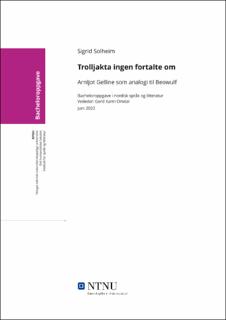Trolljakta ingen fortalte om - Arnljot Gelline som analogi til Beowulf
Bachelor thesis
Permanent lenke
https://hdl.handle.net/11250/3002890Utgivelsesdato
2022Metadata
Vis full innførselSamlinger
Sammendrag
Litt over halvveis i Heimskringlas Saga om Olav den hellige, dukker det opp en finurlig episode. Kong Olavs sendebud, en islending ved navn Torodd Snorresson, møter den storvokste og svært sterke Arnljot Gelline. Sammen reiser de i retning kongen, men stopper for å overnatte i et hus ute i skogen. I løpet av natten angripes denne hallen av ei trollkjerring, som dreper og spiser de svenske handelsmennene som også hadde søkt ly samme sted. Denne episoden har likhetstrekk med det gammelengelske diktet Beowulf. Oppgaven føyer seg dermed inn i en lang tradisjon for sammenligninger mellom norrøn og gammelengelsk litteratur. Den tar for seg både episoden og karakteren Arnljot Gelline, og argumenterer for at selv om det kan virke som om fortellingen om Arnljot og trollet gis opp halvveis, kan dette ha vært et bevisst fortellergrep så vel som et malplassert troll. A little more than halfway through Heimskringla’s Saga of St. Óláfr, a peculiar episode occurs. King Olaf’s diplomat and messenger, the Icelander Þóroddr Snorrasonar, meets the large and very strong Arnljótr gellini. Together, they travel towards the king, but stops to rest in a house for travellers in the forest. During the night, the hall where they are sleeping is attacked by a troll-woman killing and eating a party of Swedish merchants resting in the same place. This episode bears a resemblance to the old English poem Beowulf. This thesis thus places itself into a long academic tradition of comparing old norse and old English literature. The thesis looks at both the episode in itself, as well as the character of Arnljótr gellini. It argues that even if it might seem like the story of Arnljótr and the troll-woman might appear to be given up halfway through, this might have been a conscious narrative choice.
